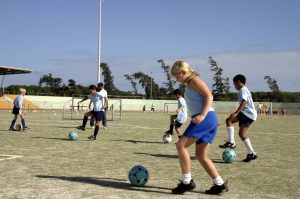The federal Afterschool Nutrition Programs provide funding to serve suppers and snacks to children alongside educational and enrichment programming, offering a solution to the nutritional and opportunity gaps that exist for too many students after the school day ends. The meals and snacks help draw children into those educational and enrichment activities, which support academic achievement and provide much-needed childcare for working parents.
And while participation in the Afterschool Meal Program continues to move in the right direction, according to an upcoming report released by the Food Research and Action Center, more needs to be done to increase its reach by expanding the number of sites operating, increasing awareness, and eliminating barriers to participation.
Policy Opportunity: Child Nutrition Reauthorization
Congress is in the process of reauthorizing the federal child nutrition programs, which creates an important opportunity to improve access to nutrition when the school day ends. Reauthorization, which generally happens every five years, is when Congress reviews the laws governing the child nutrition programs and has the opportunity to make changes to strengthen and improve the programs. The last reauthorization — the Healthy Hunger-Free Kids Act of 2010 — expanded the Afterschool Supper Program nationwide.
To fully move the needle on expanding access to afterschool meals, Congress should make additional investments in the Afterschool Nutrition Programs to overcome barriers to participation and increase the number of programs that can participate. These include:
Streamlining the Afterschool Meal Program and Summer Food Service Program
 Many community-based organizations and local government agencies operating the Afterschool Meal Program also serve summer meals to the same children through the Summer Food Service Program (SFSP). This means that sponsors must apply for and operate two distinct programs with different eligibility criteria and program requirements in order to provide meals 365 days a year. Allowing sponsors to operate one program year-round through SFSP would eliminate duplicative and burdensome paperwork while supporting sponsors’ efforts to serve more children in their community and to do it better.
Many community-based organizations and local government agencies operating the Afterschool Meal Program also serve summer meals to the same children through the Summer Food Service Program (SFSP). This means that sponsors must apply for and operate two distinct programs with different eligibility criteria and program requirements in order to provide meals 365 days a year. Allowing sponsors to operate one program year-round through SFSP would eliminate duplicative and burdensome paperwork while supporting sponsors’ efforts to serve more children in their community and to do it better.
Lowering the Area Eligibility Threshold From 50 to 40 Percent
Most afterschool sites qualify to serve meals by demonstrating that they are located in a low-income area in which at least 50 percent of the children are eligible for free or reduced-price school meals. This keeps many communities where poverty is less concentrated, such as rural and suburban areas, from participating. Lowering the eligibility threshold from 50 to 40 percent would improve access to suppers in every state. It also would align site eligibility with eligibility criteria in various federal education funding sources that can support afterschool programs, such as the 21st Century Community Learning Centers program.
What can Afterschool Advocates do?
Here are ways to get involved and help expand the reach of afterschool suppers:
- Stay up-to-date on current legislative updates and the bills FRAC is tracking at https://www.FRAC.org/action.
- Tell your story. Talk to your Members of Congress about the important role that afterschool meals play in keeping students safe, active, and healthy, and urge them to support further investments in the Afterschool Meal Program. Members of Congress can sign on and endorse the marker bills that include the proposals detailed above. Advocates can also learn more about organizing a site or office visit here.
- Share information about the program with other afterschool advocates! While participation in afterschool suppers is growing, far too many eligible programs are missing out on serving reimbursable afterschool suppers. Find more information on this important program here.
The Food Research & Action Center (FRAC) has resources to help you learn more about the Afterschool Nutrition Programs, determine if your program is eligible, and identify successful strategies for implementing them.
Coming October 23: Afterschool Suppers: A Snapshot of Participation, FRAC’s latest report on participation data in the Afterschool Nutrition Programs!
For breakfast today I had oatmeal and a banana.
Author: @clarissahayesfrac
